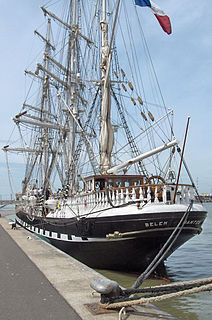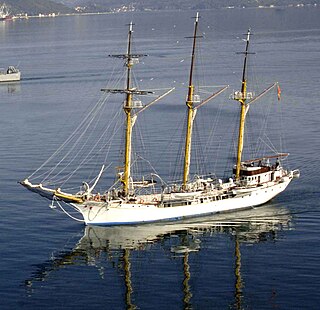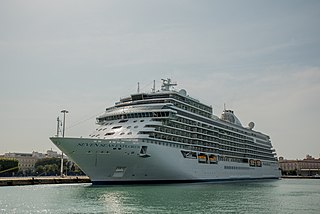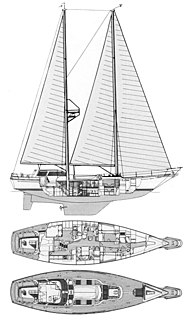
Royal Clipper is a steel-hulled five-masted fully rigged tall ship used as a cruise ship. She was redesigned by Robert McFarlane of McFarlane ShipDesign, for Star Clippers Ltd. of Sweden, the same designer behind the cruise company's first two vessels. This third one was built using an existing steel hull designed by Zygmunt Choreń that was modified by the Gdańsk Shipyard, where 24 metres (79 ft) was added to its length.

Belem is a three-masted barque from France.

A cabin or berthing is an enclosed space generally on a ship or an aircraft. A cabin which protrudes above the level of a ship's deck may be referred to as a deckhouse.

SS France was a Compagnie Générale Transatlantique ocean liner, constructed by the Chantiers de l'Atlantique shipyard at Saint-Nazaire, France, and put into service in February 1962. At the time of her construction in 1960, the 316 m (1,037 ft) vessel was the longest passenger ship ever built, a record that remained unchallenged until the construction of the 345 m (1,132 ft) RMS Queen Mary 2 in 2004.

MS Marella Dream is a cruise ship previously owned by TUI UK Ltd. and operated under charter by Marella Cruises. She was built in 1986 at the Meyer Werft shipyard in Papenburg, West Germany as MS Homeric for Home Lines. In 1988 she was sold to Holland America Line and renamed MS Westerdam. In 1990 she was lengthened by 36.9 m at Meyer Werft. In 2002 she was transferred to the fleet of Costa Cruises and renamed MS Costa Europa. In April 2010 she left the fleet of Costa Cruises on a ten-year charter to Thomson Cruises, under the name MS Thomson Dream. She is the last new build for Home Lines to remain in active service.

Marella Discovery is a former Royal Caribbean International Vision-class cruise ship now sailing for Marella Cruises. The second in the line of the Vision-class ships, she features a seven-story lobby, rock-climbing wall, and a 9-hole miniature golf course.

Preussen (PROY-sin) was a German steel-hulled, five-masted, ship-rigged sailing ship built in 1902 for the F. Laeisz shipping company and named after the German state and kingdom of Prussia. It was the world's only ship of this class with five masts carrying six square sails on each mast.

MS Nordkapp is a Hurtigruten ship built in 1996 by Kleven Verft AS, Norway, for Ofotens og Vesteraalens Dampskibsselskab for use in Hurtigruten ferry service along the coast of Norway. She is a sister ship of MS Polarlys and MS Nordnorge. Nordkapp is one of 11 ships that travel the Norwegian coast from Bergen to Kirkenes.

Jadran is a sailing ship for basic naval training built for the Yugoslav Royal Navy and currently in Montenegrin Navy service. A three-mast topsail schooner or barquentine with an auxiliary engine, Jadran was built in Hamburg, Germany between 1930 and 1933, and commissioned on 19 August 1933. Prior to World War II she completed seven long training cruises with trainees from the Yugoslav Naval Academy, including one to North America. As Yugoslavia was neutral at the outbreak of World War II, Jadran was able to conduct short cruises in the Adriatic Sea. In April 1941, Yugoslavia was invaded by the Axis powers, and Jadran was captured and renamed Marco Polo by the Italian Navy. She continued to be used as training ship in the Adriatic, operating out of the Istrian port of Pola, and was featured in an Italian propaganda film.

Sea Cloud is a sailing cruise ship owned by Sea Cloud Cruises of Hamburg, Germany. Launched as a private yacht in 1931, it served as a weather ship for the United States Coast Guard and United States Navy during World War II, when it became the U.S. military's first racially integrated warship since the American Civil War. After the war, Sea Cloud was returned to private ownership, serving as a yacht for numerous people, including as presidential yacht of the Dominican Republic. Since 1979, Sea Cloud has been used as a cruise ship.

MS Viking Grace is a cruiseferry constructed at STX Europe Turku Shipyard, Finland for the Finland-based ferry company Viking Line. The ship was delivered to her owners on 10 January 2013, and entered service on 13 January 2013. She is the first large-scale passenger ferry to be powered by liquefied natural gas (LNG) as well as being fitted with a rotor sail.

MV Viking Star is the lead ship of the Viking Star class of cruise ships, and the first such ship operated by Viking Ocean Cruises, a division of Viking Cruises. She entered service in April 2015. Two Viking Star-class sister ships, Viking Sea and Viking Sky, joined her in the Viking Ocean Cruises fleet in 2016.

Seven Seas Explorer is an Explorer-class cruise ship currently operated by Regent Seven Seas Cruises, a subsidiary of Norwegian Cruise Line Holdings. Debuting in 2016, she became the first new-build ship for Regent in more than a decade and the largest ship to ever operate for Regent.

The Royal Albatross is a privately owned, four-masted Barquentine, luxury super yacht. She operates from her home berth at Resorts World Sentosa on the island of Sentosa in Singapore. The Royal Albatross is a unique luxury tall ship with four masts, 22-sails, more than 200 ropes, three decks and is comparable with a luxury yacht; but unlike the typical super-yacht, it looks and operates like an old-world galleon. Her sails and rigging were designed by Jim Barry who designed the ship for the Pirates of the Caribbean movies. After a 5.5 year reconstruction, the Royal Albatross is one of Singapore's premier hospitality venues with a passenger capacity of 200 (alongside) and 149 (sailing) all of which can be accommodated on a continuous upper deck.

The C&C Custom 67 is a Canadian sailboat, that was designed by Robert W. Ball of C&C Yachts and was launched and named Archangel in September 1980. She remains the largest pleasureboat commission ever received by C&C, and epitomized a trend within C&C during the later 1970s and early 1980s toward more cruising-oriented designs under George Cuthbertson's direction, a trend best illustrated by the development of the Landfall series.
The Catalina 375 is an American sailboat that was designed by Gerry Douglas as a cruiser and first built in 2008.
The Dovekie 21, often called just the Dovekie, is an American sailing dinghy, named for the sea bird. It was designed by Phil Bolger as a cruiser and first built in 1978.
The Albin 82 MS is a Swedish sailboat design that was designed by Per Brohäll as motorsailer and first built in 1975.
The Ericson 25+, also called the Ericson 25 Mark II, is an American trailerable sailboat that was designed by Bruce King as a cruiser and first built in 1978.
The Sea Pearl 21 is an American trailerable sailboat or sailing dinghy, that was designed by Ron Johnson as an daysailer and first built in 1982.


















